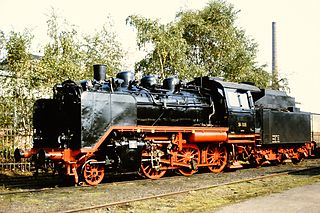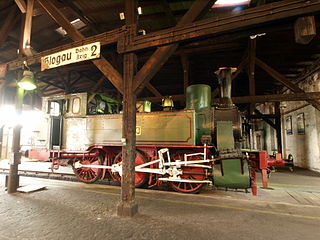
The DRG Class 86 was a standard goods train tank locomotive with the Deutsche Reichsbahn-Gesellschaft. It was intended for duties on branch lines and was delivered by almost all the locomotive building firms working for the Reichsbahn. From 1942 it was built in a simplified version as a 'transitional war locomotive'. The most obvious changes were the omission of the second side windows in the cab and the solid disc carrying wheels.

The Bavarian Class GtL 4/4 engines were superheated steam locomotives in service with the Royal Bavarian State Railways for duties on branch lines (Lokalbahnen).

The six-coupled P 5 of the Palatinate Railway (Pfalzbahn) was to replace the four-coupled locomotives in the Palatinate. They were given a leading Krauss-Helmholtz bogie and a trailing bogie in order to achieve satisfactory weight distribution.

The DRG Class 24 steam engines were German standard locomotives (Einheitslokomotiven) built for the Deutsche Reichsbahn between 1928 and 1939 to haul passenger trains.

The Class 62 engines were standard passenger train tank locomotives of Germany's Deutsche Reichsbahn-Gesellschaft (DRG).

The locomotives of the German DRG Class 81 were standard (Einheitsdampflokomotiven) goods train tank locomotives with the Deutsche Reichsbahn-Gesellschaft (DRG).

The DRG Class 89.0 was a goods train tank engine of standard design built for the Deutsche Reichsbahn (DRG).

The Prussian T 18 was the last class of tank locomotives developed for the Prussian state railways. They were originally intended for services on the island of Rügen as replacements for Class T 12 and T 10 engines. They emerged when a class of locomotive was conceived in 1912 that was to handle express and passenger trains in border areas or in shuttle services on short routes. A tank engine design with symmetrical running gear was envisaged because, unlike a tender locomotive, it could run equally fast forwards and backwards and could be operated on return journeys without having to be turned on a turntable. Its power and top speed were to be the same as those of the P 8. Robert Garbe designed this 4-6-4 (2′C2′) tank locomotive for 100 km/h with a 17-ton axle load and contracted the Vulkan Werke in Stettin to build it. It was given the designation T 18.

Between 1934 and 1941 the Deutsche Reichsbahn (DRG) converted a total of 691 former Prussian-built Class 55.25–56 steam locomotives; the result was the DRG Class 56.2–8. The carrying axle enabled higher speeds and the engine could even be used as a passenger train locomotive. In addition the average axle load was lower, so that these locomotives could also be used on branch lines. The conversion entailed moving the boiler forward and raising it somewhat. The vehicles were given operating numbers between 56 201 and 56 891, although the numbering was not continuous.

The DR Class 65.10 was a four-coupled passenger train tank engine operated by the East German Deutsche Reichsbahn (DR) for heavy suburban and commuter services.

The Prussian T 16.1 locomotives were built for the Prussian state railways as goods train tank locomotives about the time of the First World War. Six examples were also procured by the Imperial Railways in Alsace-Lorraine.

The Mecklenburg T 4 was a German steam locomotive built for the Grand Duchy of Mecklenburg Friedrich-Franz Railway as a goods train 2-6-0T with a leading axle and three coupled axles. In 1925 it was incorporated in the renumbering plan of the Deutsche Reichsbahn as DRG Class 91.19.
Locomotive numbers 1 to 3 on the Lübeck-Büchen railway in Germany were streamlined tank locomotives. The locomotives had a 2-4-2T wheel arrangement, a two-cylinder, superheated engine and were capable of push-pull operations. In order to ensure a symmetrical running gear, both carrying axles were built as Bissel bogies, which were fitted with return devices for improved running.

The Baden VI b was the first German tank locomotive with a 2-6-2 wheel arrangement. It was developed by the firm of Maffei for the Grand Duchy of Baden State Railways in order to provide faster services on the Höllentalbahn. As a result, the first six batches were given a firebox sloping to the rear. One striking feature was also the connecting pipe between the two steam domes.

The Prussian Class T 10s were tank locomotives operated by the Prussian state railways. They were procured for duties between Frankfurt and Wiesbaden between 1909 and 1912. This 41-kilometre (25 mi) long route between the two termini was to be worked without turning the locomotive. Because the engine tended to derail, in practice it was turned whenever possible. On these engines, supplied by Borsig, the boiler from the Prussian P 6 and the running gear and drive from the Prussian P 8 were used. The boiler had to be positioned further forward than was usual on other locomotives in order to even out the distribution of weight, because the design omitted any trailing wheels. The first trial runs took place on 30 June 1909.

The Prussian T 14s were German, 2-8-2T, goods train, tank locomotives operated by the Prussian state railways and the Imperial Railways in Alsace-Lorraine. They were later incorporated by the Deutsche Reichsbahn into their renumbering plan as Class 93.0–4.
The Prussian G 8.2 class of locomotives actually incorporated two different locomotive types: one was the Prussian/Oldenburg G 8.2, for which the Deutsche Reichsbahn subsequently issued follow-on orders; the other was the G 8.2 of the Lübeck-Büchen Railway.

The Prussian T 8 were six-coupled superheated goods tank locomotives of the Prussian state railways. They were originally intended for suburban passenger service in Berlin, and for use on branch lines. Due to their poor running qualities, they were demoted to shunting and short-distance goods train service.

The Prussian T 7 was a group of goods tank locomotives of the Prussian State Railways with an 0-6-0T wheel arrangement. It was not a class in the modern sense of identical locomotives.



















